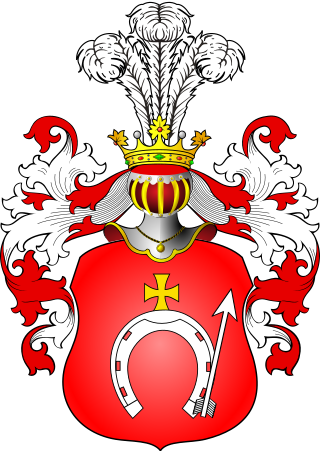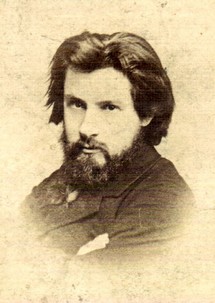
Wieniawa is a Polish coat of arms. It was used by several noble, in Polish language szlachta families in the times of medieval Poland and the Polish–Lithuanian Commonwealth.

Ostoja is a Polish coat of arms that probably originated from Sarmatian Tamga and refer to Royal Sarmatians using Draco standard. Following the end of the Roman Empire, in the Middle Ages it was used by Ostoja family in Lesser Poland and later also in Kujavia, Mazowsze and Greater Poland. It is a coat of arms of noble families that fought in the same military unit using battle cry Hostoja or Ostoja, and that applied their ancient heritage on the coat of arms, forming a Clan of knights. Later, when the Clan expanded their territory to Pomerania, Prussia, Slovakia, Hungary and Romania they also adopted a few noble families of Ruthenian origin that in 14-15th century settled down in Lithuania, Belarus and Ukraine, finally turning into the Clan of Ostoja. As different lines of the clan formed surnames after their properties and adding the adoptions, Ostoja was also recognized as CoA of several families that was not necessary connected to the original Clan, forming Heraldic clan.

Wielbark is a town in Szczytno County, Warmian-Masurian Voivodeship, in northern Poland. It is the seat of the gmina called Gmina Wielbark. It lies approximately 19 kilometres (12 mi) south of Szczytno and 52 km (32 mi) south-east of the regional capital Olsztyn. It is part of historic Masuria.

Stanisław Masłowski was a Polish painter of realistic style, the author of watercolor landscapes.

The Warsaw National Museum, also known as the National Museum in Warsaw, is a national museum in Warsaw, one of the largest museums in Poland and the largest in the capital. It comprises a rich collection of ancient art, counting about 11,000 pieces, an extensive gallery of Polish painting since the 16th century and a collection of foreign painting including some paintings from Adolf Hitler's private collection, ceded to the museum by the American authorities in post-war Germany. The museum is also home to numismatic collections, a gallery of applied arts and a department of oriental art, with the largest collection of Chinese art in Poland, comprising some 5,000 objects.

Siekierki is a low-rise housing residential neighborhood in Warsaw, the northeastern part of the Mokotów district belonging to Lower Mokotów, adjacent to the Vistula river. The area is home to an astronomical research center of the Polish Academy of Sciences and a Marian sanctuary.
Middle Polish is the period in the history of the Polish language between the 16th and 18th centuries. It evolved from Old Polish, and gave rise to Modern Polish.

Władysław Łuszczkiewicz was a Polish historian and painter of the late Romantic era from Kraków, active in the period of the foreign partitions of Poland. He was a professor at the Academy of Fine Arts and served as its principal in 1893/95. One of his best students was Jan Matejko, the eminent Polish historical painter and later, his close associate. Łuszczkiewicz taught painting, drawing, anatomy and architectural styles. Highly educated, he also worked as conservator of architectural monuments in the city later on in his career, and wrote historical dissertations.

Anna Ziaja is a Polish contemporary painter and print maker.

Jarosław Saturnin Leitgeber was a Polish writer, bookseller and publisher. His brother, also a book bookseller and publisher, Mieczysław Antoni Leitgeber, inspired his career. Jarosław got his experience by working with his brother, interrupted only by military service in 1869.

Szeptycki was a major noble family in Ruthenia. The family was related to a number of other noble families, such as the Wiśniowiecki, the Ledóchowski or the Fredro.

Fyodor Fyodorovich Buchholz, born Teodor Buchholz was a painter, graphic artist and art teacher from the Russian Empire. He specialized in genre and historical scenes. Some of his works became popular postcards.

Jan Kanty Ignacy Maszkowski (1794–1865) was a Polish painter; known for portraits, history and genre paintings.

Parys Filippi was a Polish sculptor. His father was an Italian sculptor and stuccoist named Paolo Filippi.

Feliks Michał Wygrzywalski was a Polish painter remembered primarily for his Orientalist scenes and portraits. He also created a significant number of nudes. His son, Feliks Kazimierz Wygrzywalski, was also a painter.

The Rainbow Landscape is a 1640 oil-on-panel painting by Peter Paul Rubens, now in the Alte Pinakothek in Munich. One of the painter's last works and the third of three autograph works on the same subject, it mixes Italian and Flemish influences in a style reminiscent of Rubens' friend Jan Bruegel the Elder but with figures drawing on nymphs from the work of Annibale Carracci and Domenichino.

The Nagorski family - Polish noble family with the coat of arms of Ostoja, belonging to the heraldic Clan Ostoja (Moscics), originating from Nagorzyce (Nagórzyce) in the former province Sandomierz.

Moonrise is a 1884 nocturne, landscape painting by the Polish artist Stanisław Masłowski. It is an oil-on-canvas painting, which measures 124 x 220 cm and is signed: "SMasłowski/Wars. 84.".

Blind Veit Stoss with his granddaughter is an oil painting by Jan Matejko painted in 1865. It belongs to the collection of the National Museum in Warsaw.

Adam Gorczyński was a Polish writer and poet of the Romantic era, author of popular novels in the style of gawęda szlachecka and Old Polish silvae rerum, a painter of the Polish Romantic era, an artist of Polish landscapes, co-founder of the Kraków Society of Friends of Fine Arts, politically engaged in Polish affairs in Galicia, a social activist, and owner of estates in Brzeźnica and Marcyporęba. He used the literary pseudonym "Jadam of Zator". In the 21st century, he became the patron of cultural initiatives in his hometown of Brzeźnica.



















